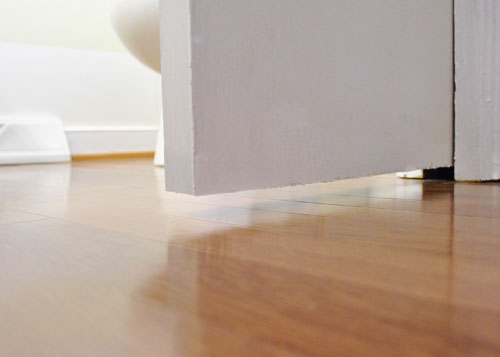When pocket doors begin to deteriorate, scratches often appear, but the good news is that this can be fixed. They are extremely practical to use, but if your pocket doors are scratching or keeping from opening, this article contains instructions on how to fix them.
Long days of door use frequently result in scratched doors. It can be annoying because the scratched doors can make you crazy.
Long-term, it simply ruins the doors’ aesthetic appeal and outside view. Do you know how to fix pocket door scratching? Or, how do you stop the rattling and scratching?
Fortunately, you only need a few simple tools, supplies, and a basic understanding of the process to solve this problem. This article will demonstrate how to restore damaged pocket door scratching. For advice on how to make your pocket door look brand new once more, continue reading!
Steps to Fix Pocket Door Scratching
When trying to conserve floor space, pocket doors are very helpful, but if they are installed incorrectly, have a cavity issue, or are simply not in line with the wall, they may scratch easily.
When they begin to scratch, pocket doors can quickly change from being pleasant to frustrating. Fortunately, you can quickly fix this.
Reattach the Baseboards
Removing the entire pocket door and determining whether the baseboard has been installed correctly is one of the simplest ways to fix scratching pocket doors.
Reattaching the baseboard is the only solution if your pocket door is scratching it; this is frequently thought to be the root of many pocket door scratching problems.
Modern pocket doors may not be affected by this because they are built with superior hardware that prevents them from scratching the baseboard. You can take out the nails and use glue to reinstall the baseboard after completely removing the pocket door to check if it was installed correctly.
Adjust the Tracking

Simply put, the tracks might not be adjusted properly. One of the simplest solutions for pocket door scratching problems is to simply adjust the track, but this can be challenging if the door is framed.
You should first take out the sliding door and any trim from the sides and panel if your pocket door’s problem is an out-of-place track. After drilling a hole in the wall to access the track, you can reinstall the pocket door. note that this is a bit tricky since the track is hidden behind the pocket door.
Review the Wall
Check to see if there is a problem with the plumb wall if your door keeps getting stuck and scratching up; it may not be properly aligned. If you hold the spirit up to the wall, the lateral bulb can help you determine whether the wall is straight or not. If it isn’t, you can loosen the screw holding the track to the wall to make it straighter.
Install a Door Sweep
Installing a door sweep is another highly advised method for repairing scratching on pocket doors because it will help stop anything from slipping out and harming the door. A door sweep is a tool that fastens to the bottom of the door and fills in any gaps.
Oil the Door Hinges
The majority of pocket doors only require lubrication to prevent scratching. Therefore, try lubricating the door hinges and see if the door itself needs to be lubricated.
Applying a thin layer of petroleum jelly or lubricant with a silicone base to the track, door, and hinges should get the pocket door moving smoothly. Oiling the door hinges can also protect the floor from the door.
Use a Wood Filler
Last but not least, if the pocket door itself has a deep scratch, you can try using wood filler. However, the area must first be cleaned, smoothed out with a putty knife, and allowed to dry. It may be temporary, but sanding it might help. Consider replacing the damaged pocket door panel if the scratching is severe.
Different Ways to Fix Pocket Door Scratching

Pocket doors are a stylish and practical addition to any house, but if they start to scratch, they can also be a source of irritation. Fortunately, there are a few quick fixes that can keep your doors looking brand-new.
Get a Handle on the Problem
Although they are excellent space savers, pocket doors can be very difficult to keep scratch-free. Hence, locating the problem’s origin is the first step. Do your children frequently slam doors, for instance? Or perhaps your pet is trying to enter or exit by scratching at the door.
Trim Their Nails
If your pets are the culprits, keeping their nails trimmed is one way to resolve the issue. To make their nails less likely to cause harm, you can also try roughening the edges with a nail file.
Protect the Door With a Barrier
Placing a barrier between the door and the floor will also shield your pocket door from scratches. The solution is a piece of cardboard or a few carpet scraps.
Stick on Some Felt
Another option would be to use felt pads to cover the bottom of the door. By doing so, any impacts will be absorbed and scratches will be avoided.
Install a Door Sweep
A straightforward tool called a door sweep fastens to the bottom of the door and aids in filling in any gaps. Any objects that might slide underneath and harm the door will be prevented by doing this.
Add Some Weatherstripping
Another quick method to fill in any gaps around your pocket door is weatherstripping. This will shield your door from scratches and help keep dust and drafts out.
Give Them Something Else to Scratch
You might need to give your pets a different place to scratch if they insist on gnawing on your pocket doors. Consider setting up a scratching post or mat next to the door to give them something else to do so.
The scratching of pocket doors doesn’t have to be a constant issue, regardless of the solution you select. You can maintain your doors’ pristine appearance for many years with a little work. For more information on how to repair pocket door scratching, continue reading.
What Are the Causes of Pocket Door Scratching?

Saving space in your home by installing a pocket door is a great idea, but if the door is installed incorrectly, your walls could be harmed. When pocket doors are opened or closed, one of the most prevalent issues is that they can scratch the wall.
This is so that the paint or wallpaper won’t get damaged over time when the door is moved, which causes the door to rub against the wall.
Make sure the door is installed correctly and that there is enough space between it and the wall to avoid this from happening. To prevent dings on the wall, you can also install a piece of trim around the door. By taking these precautions, you can keep your walls looking brand-new for many years.
Why Should You Fix Pocket Door Scratching?
Although pocket doors are a fantastic space-saving option, if they start to scratch, they can also be very frustrating. It not only looks bad, but it may also make it difficult or impossible to open and close the door. Fortunately, there are a few simple fixes for scratched pocket doors.
To start, try cleaning up any dirt or debris that might be the problem with a soft cloth or brush. If that doesn’t work, try using fine-grit sandpaper to sand the area.
In the majority of cases, this will be sufficient to enhance the door’s appearance and functionality. However, if the damage is severe, you might have to completely replace the door.
Whatever the reason, pocket door scratching is a simple issue to resolve. With a little work, you can maintain the appearance and functionality of your doors.
What is a Pocket Door?

An example of a door that slides open and shut horizontally without the use of hinges is a pocket door. When a swinging door would be in the way or in a small room, pocket doors are a great space-saving option. In order to allow the door to slide back and forth, pocket doors typically have tracks at the top and bottom of the door frame.
Additionally, some pocket doors have rollers that aid in maintaining the door’s position. Wood, glass, or metal are just a few of the materials that can be used to create pocket doors.
For closets, bathrooms, and laundry rooms, pocket doors are a popular option. However, they can also be used in other rooms of the house, like bedrooms or offices.
FAQs
Are Pocket Doors Hard to Maintain?
challenging to install and maintain Pocket doors are hard to install and require precision for correct operation, usually making them unsuitable for They are more difficult to fix than regular doors and more prone to malfunctioning.
How Do You Keep a Pocket Door from Scraping?
The door is warped or the studs are bowed if you can see the distinctive rub marks. Either way, though, one fix is to replace the door. A replacement door with the same thickness could solve the issue if the door is warped. Replace the door with a thinner one (for example, swap a 1-3/4 in.
Is a Pocket Fixing Door More Expensive Than a Regular Door?
A pocket-fixing door isn’t more expensive than a standard door, no. They frequently cost the same, in fact. The size and style of the door you select will affect how much a pocket door costs.
Conclusion: Fix Your Pocket Door
You shouldn’t worry if you’re having this issue. A scratching pocket door can be fixed in a number of different ways. We’ll walk you through each step so you can quickly restore the functionality of your door.
It is not desirable to have scratches on a wooden door because they can make it look dingy and ugly. It’s normal to want to get rid of unsightly blemishes, and fortunately, doing so doesn’t have to be challenging.
If you found this post helpful, please spread the word.





